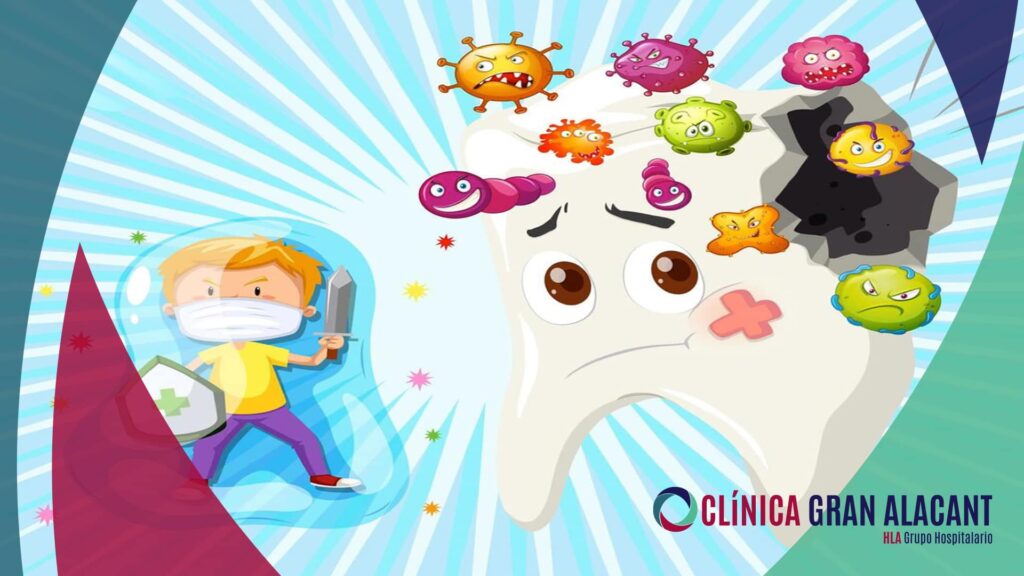One of the most frequent doubts for parents are the cavities in the milk teeth. In our blog we hope to solve these doubts.
Frequently Asked Questions about Cavities in Baby Teeth
Cavities in the temporary dentition (first teeth that come out between approximately 6 months to 2 years) are a common problem within the dentist’s surgery.
What is a cavity?
It is the chronic pathology (call it chronic because that damaged piece will not be the same, even if it is repaired) caused by bacterias, that live inside the mouth and can produce a small or large hole in the tooth, which is called a cavity.
How do cavities occur in children?
Bacterias need a suitable medium to reproduce, requiring dental plaque or tartar, food components and/or habits such as glucose (sugars) consumption and brushing deficit.
This is the perfect way for bacteria in the mouth to trigger a metabolic reaction (chemical processes for the reproduction of these bacteria) that produces acids, such as lactic acid, capable of dissolving the enamel layer (the hardest and most superficial layer of the tooth), thus causing cavitations in the teeth that if not detected in time, prevented or treated, can lead to poor oral health in children.
If this problem is detected in time, you have a simple and economical solution. If it is not solved, it can cause pain, gum inflammation, fear of the dentist, loss of temporary teeth or even of the definitive ones, and more expensive and long lasting treatments.
What should we do to avoid cavities?
The prevention of caries should start from the eruption of the first teeth, as this will prevent the appearance of the first dreaded child caries called rampant or baby bottle, this prevention habit should be instilled and remain in time.
It is important that during the first years of life parents are persistent in oral hygiene, once children are able to handle the brush we must review and revise the procedure. It is necessary to show as something positive the cleaning, care of the oral cavity and periodic review to the dentist normally, in order to create a good oral health education.
Habits to avoid the appearance of cavities:
- Moderate the consumption of foods rich in sugars and carbohydrates
- Brush your teeth and tongue at least twice a day (ideally after every meal), being the night brushing the most important one.
- Periodic reviews of the brushing technique as to follow the advice of the pediatric dentist.
- Use age-specific toothpastes from the age of 2.
- Hygiene of pacifiers, bottles, teeth teethers.
- Balanced diet of fruits and vegetables.
- Increase water intake.
- Brushing teeth after any medication.
- In the case of infants who do not yet have teeth, the gums should be cleaned after each meal with a gauze moistened with water.
Why is it necessary to cure cavities in baby teeth?
From the eruption of the first milk teeth until about 12 years (age at which the change of temporary teeth to permanent teeth is made) it is important that these temporary teeth are kept healthy and with good hygiene because this will allow children to have a good oral development and a good diet.
Due to their composition, milk teeth are easier to decay and therefore their care must be daily and precise.
- The main reasons why these cavities must be cured from the first symptoms are secondary health problems since these cavities are sources of infection.
- Problems in permanent teeth: stains, formation damage or cavities.
- Changes in eating habits due to pain.
- Bad occlusion and chewing due to pain or lack of pieces which causes dental overload in other pieces.
How to cure these cavities?
In the visit to the dentist will determine the appropriate treatment to cure the piece or pieces with some pathology.
Depending on the size of the cavities and the number of damaged pieces, a periapical radiography (specific radiography of one or several pieces) or an orthopantomography (global radiography to check the state of the whole mouth) may be performed where we can define the state of the tooth and its future. These radiological studies allow us to know how much time you have left until your exfoliation (fall), type of treatment to be performed: filling, pulpotomy (endodontics in milk teeth), extraction and placement of space maintainer (a type of oral orthopedics so that the space where the extracted piece was kept until the new eruption of the final piece).
Other associated pathologies:
- Bad Breath
- Bleeding and swollen gums
- Pain
- Mobility and/or early tooth loss
- Bad occlusion
- Poor dental formation and development of the oral cavity.
Fluoride
Fluoride is the perfect complement to dental cleaning, it is an essential component for the healthy maintenance of teeth. It helps us remineralize the enamel layer making it strong so that the acids that cause cavities cannot act.
We can find fluoride naturally in small amounts in many foods such as fish, vegetables or fruit and also in water.
We can also find it in most toothpastes or mouthwashes for adults and children. It is important that at each stage of our children’s growth they have the right amount of fluoride, always under the recommendations of the dentist.
Dental check-up in Gran Alacant
It is important to go to the dentist’s surgery from the first eruption of our children’s teeth, as this can begin to rule out diseases early.
Once the first revision is done, it is advisable to do it again every 6 months and if necessary every 3 months.



